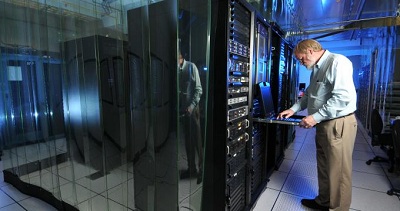ACADEMIA
Slashing the energy footprint of climate research
Technologies installed at the University of Colorado Boulder's National Snow and Ice Data Center have slashed the center's energy footprint by more than 70 percent.
The green renovations include a novel indirect evaporative cooling system and a solar power array. The center has received a High-Impact Research Award from Gov. John Hickenlooper, as well as the Green Enterprise award from the Uptime Institute and a sustainability award from CU-Boulder.
The indirect evaporative cooling system for the center's computer bank, which is accessed by researchers around the world who study Earth's snow, ice and climate, blows air over water, producing a coolant without humidity. The dryness is important because humidity can damage computers.
"The technology works and it shows that others can do this too," said David Gallaher, NSIDC's technical services manager. "Data centers are big consumers of energy and a lot of it is for cooling. Even in the dead of winter, our computer room air conditioners were cranking full tilt, trying to chill the 100-degree-plus heat coming off the back of these units."
Before the installation of the cooling system, more than 300,000 kilowatt-hours of energy per year -- enough to power approximately 34 homes -- were required to cool the facility.
"Smart controls" also make the NSIDC's supercomputer room design more sustainable. They circulate air from the outdoors during much of the year, and automatically switch on the cooling system when temperatures reach a certain threshold.
More than 700 locally manufactured solar panels installed on the center's roof produce approximately 50 kilowatt-hours of energy. They feed the electrical grid, reducing the center's net carbon footprint. In case of a power outage, the array charges backup batteries that can keep the NSIDC running.
In addition to Gallaher, the center's design team includes Mark Serreze, NSIDC director, and Ronald Weaver, NSIDC principal investigator and manager of the NASA Distributed Active Archive Center. The project also involves Otto Van Geet of the U.S. Department of Energy's National Renewable Energy Laboratory, Rick Osbaugh of the RMH Group and Lee Gillan of Coolerado Corp.
NSIDC received a grant for its sustainability implementations from the National Science Foundation under its Academic Research Infrastructure Program with additional support from NASA. NSIDC manages scientific data from NSF field programs and from NASA's Earth Observing System remote sensing program.
NSIDC is part of the Cooperative Institute for Research in Environmental Sciences -- a joint venture of CU-Boulder and the National Oceanic and Atmospheric Administration -- and supports research into Earth’s frozen regions including sea ice, snow cover, glaciers, ice caps, ice sheets, permafrost and climate interactions.
For more information and to view monitoring of the computing center's energy use and cooling system visit http://nsidc.org/about/green-data-center/project.html.

